March 20th was the one-year anniversary of the Jason Calacanis interview of David Heinemeier Hansson on This Week in Startups. Our industry could use more public debates like this.
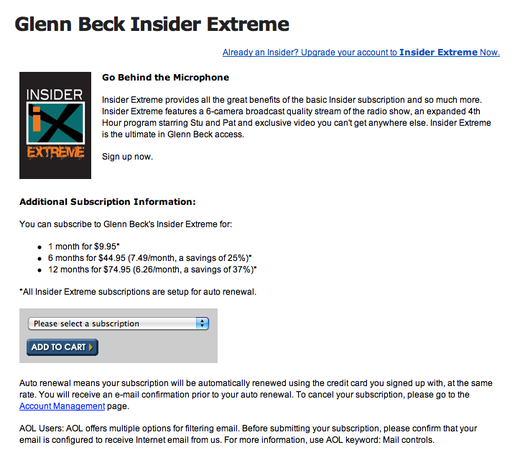
Sad when the The New York Times can learn a thing of two from Glenn Beck.
The Emeco 1006 chair
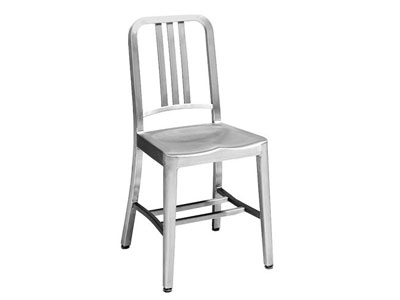
It takes 77 steps to make an Emeco 1006 chair. It’s made from 12 different sections by 50 people and they need 8 hours to do it. At each step along the way, the chair is ground to smooth out the welds and create a seamless look. The end product is nearly indestructible and built to last for 150 years.
Once found on destroyers and submarines in the 1940s, this article in Metropolis talks about how the chair has become a favorite of designers. In fact, Philipe Starck agreed to offer updated designs for no fee.
“I was worried that Philippe would want a huge fee to design for us, but he didn’t even discuss money until I told him that I couldn’t afford to pay him anything. I offered him a stake in the company. He said he didn’t want one.” Instead Emeco will pay Starck an undisclosed royalty. “He could’ve taken his designs to Steelcase and made a big, fat fee.”
Starck chose to design for Emeco for a simple reason. “I have always admired the way the Emeco chair is put together,” he says. “I thought if I could design a line of furniture that becomes a classic like that chair, then I would be doing something great. I have designed a great number of things I am not proud of, and they are no longer around. I want to design things that are here forever. I think it’s time to stop wasting what’s on the planet.”
There’s more on the Starck collaboration at the Emeco site. He writes, “It is a chair you never own, you just use it for a while until it is the next person’s turn. A great chair never should have to be recycled. This is good consideration of nature and mankind.”
The site also offers a neat documentary on the company and its design process. It talks about the “ping ponging” between designers and manufacturers and how the company builds dozens of actual chairs as prototypes before finalizing a design. One designer says, “Sometimes you don’t get around to doing the final drawings. Sometimes the chair is the drawing.”
Also revealed in the doc (though perhaps just legend): The 1006’s seat was molded after Betty Grable’s bottom.
Going back to the Metropolis article, it mentions seven ads Emeco ran in Fortune back in the 1950s.
Each one depicted a different sculpture by Rodin; above the bronzes, in large letters, the ads read: “Sculpted Masterworks.” The name Emeco was in small letters at the bottom. “A lot of people called, asking, “What do you make?’” recalls Emeco’s chief operating officer at the time.
Sounds like a forerunner to Apple’s Think Different campaign.
Summer internships at 37signals
For the first time we’re looking to bring on two interns this summer. We’ve always wanted to explore internships, but we never really had the space to make it happen. Now that we have our own office, it’s go time.
The summer internships are paid ($3000/month) and last ~3 months. You must live in Chicago or be willing to relocate to Chicago for duration of the internship. For those who haven’t been to Chicago in the summer, it’s a beautiful place to be.
Designer Internship
We’re looking for a student who wants to work on real design projects this summer at 37signals. The projects will involve designing user interfaces for web apps and/or marketing sites for these web apps. You’ll design, write copy, and be thoughtfully mentored by the design team at 37s. Apply for the designer internship.
Programmer Internship
We’re looking for a student who wants to work on real programming projects this summer at 37signals. The projects will involve using Ruby, Rails, and JavaScript. You’ll develop applications from scratch and/or work on existing applications while being thoughtfully mentored by the programming team at 37s. Apply for the programmer internship.
How Inventables makes a site that inspires exploring
Inventables, “the innovators hardware store,” specializes in materials that designers, artists, and inventors use to develop new products and make new things. The site is filled with neat stuff but faces a tough challenge: selling things that people have never seen before and don’t know they want/need. The site responds by diving deeper with product descriptions, photography, sample usage, etc. Here’s the product page for Hand Moldable Plastic at Inventables:
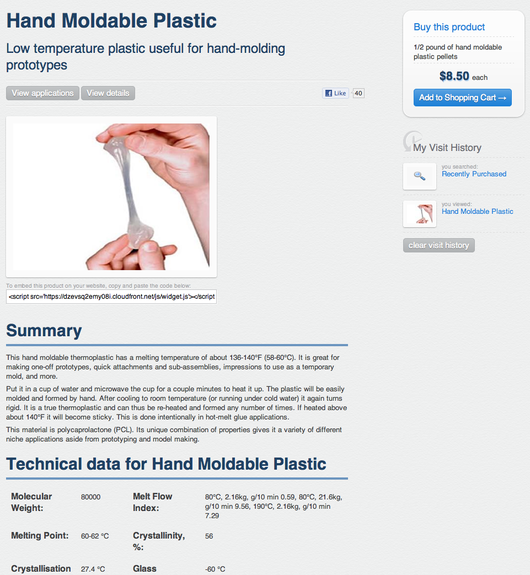
It’s interesting to see how this page differs from other sites that sell moldable plastic. Elsewhere, you just see a picture of the product in a jar. Inventables shows it in use by human hands.
Elsewhere, it’s called simply “Moldable Plastic.” Inventables adds a helpful descriptor, calling it “Hand Moldable Plastic: Low temperature plastic useful for hand-molding prototypes.”
Elsewhere, the only specs listed are the size of the jar it comes in: “3.5×3.5×3.8 inches; 13.8 ounces.” Inventables gives you stats on the actual substance, including Crystallisation Temperature, Viscosity, Melt Flow Index (whatever that is).
 That level of detail, combined with a curated product mix, is how the site competes with bigger retailers. According to Zach Kaplan (right), CEO of Inventables, the goal is to inspire customers. “Part of making it accessible is making it inspiring. It has to have that design aspect to it,” says Kaplan. “Otherwise it looks like any other retail site and we’re just selling a jar of resin pellets.”
That level of detail, combined with a curated product mix, is how the site competes with bigger retailers. According to Zach Kaplan (right), CEO of Inventables, the goal is to inspire customers. “Part of making it accessible is making it inspiring. It has to have that design aspect to it,” says Kaplan. “Otherwise it looks like any other retail site and we’re just selling a jar of resin pellets.”
Since it’s selling a world of foreign objects, an environment tailored to discovery is key for the site. Kaplan says, “If you know what you want, then yes, you can go to Amazon and type it in and get to it. But if you don’t know what you want, that jar is not helping you.”
That’s why you get things like scientific specs and in-use photography at the site. “Our pictures are very expensive,” explains Kaplan. “I guarantee you we’re paying a lot more for pictures than other sites are paying. We’re trying to ignite your imagination. And to make you think, ‘What could I do with this?’ At other places, it’s more of a catalog than a place to go explore.”
Inventables also gives examples of how others are using each product in order to spark ideas. For example, the Applications section for Temperature-Sensitive Glass (below) shows how people have used it in shower installations and interior design. The Details section explains what’s unique about the product, why it’s better than alternatives, and more.
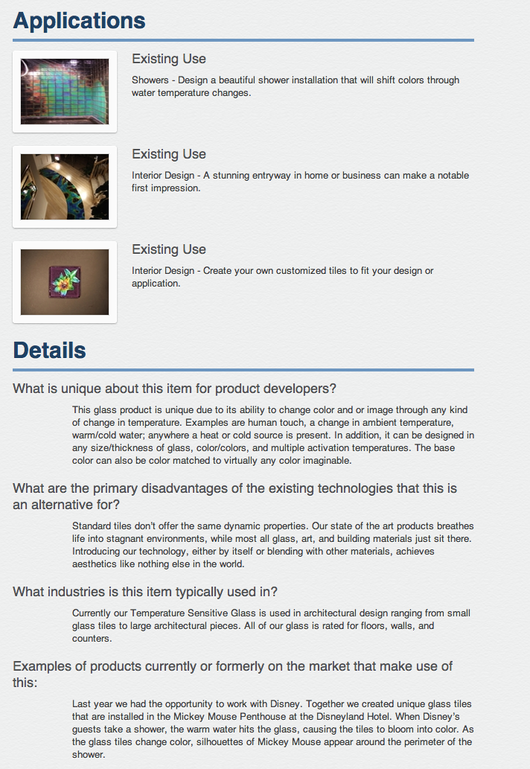
It’s a good lesson for anyone who’s trying to compete with bigger competitors. If you’ve got a smaller product mix, you can obsess over these details in a way that big guys can’t. Customers respond to that.
Continued…His job was to be alive to detail.
A wonderful sentence from The Big Short by Michael Lewis.
The usual industry angle on these things is to debate whether anyone is willing to pay, or what the price point is, or how it will affect competition. But as much as people point to the success of paid media like iTunes, they forget the key lesson of an average consumer being able to understand that a single song costs $0.99. What do I get from The New York Times for $0.99? Or for $99? I don’t really know, and I don’t know how long it will last. And if as a reader I can’t understand that simple transaction, and can’t anticipate how it affects my behavior of searching, reading, and sharing stories, then I might respond to the whole initiative by just throwing up my hands and going somewhere else.
Anil Dash on the NY Times’ pay plan
Product Blog update: Changes to Basecamp email notifications, using Highrise with MailChimp and Formstack, etc.
Basecamp
Tips: Make sure your time stamps show up accurately in Basecamp. You can create an announcement that appears at the top of a project’s Overview page. The announcement can describe the project, give a special heads up, or say anything else you want people to see. The footers of Basecamp messages now show a list of everyone who is receiving the email. We also changed the way Basecamp email notifications appear in your inbox. Notification subjects will always show the name of the project in brackets at the beginning of the subject line. Maybe you’d like to set up an email filter for messages, like this one in Apple Mail:
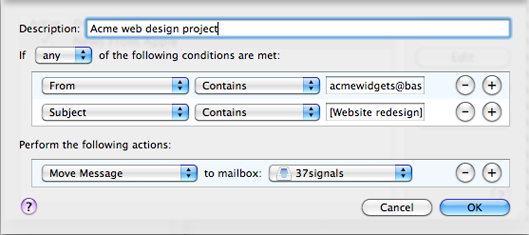
Extras: BugDigger lets you create bug reports at the push of a button — and it integrates with Basecamp. bcToolkit, a Basecamp reporting tool, announced an update that fixes issues with moved to-do lists. Video Bug Recorder for Basecamp is a Windows tool that records video from your screen and uploads it to your Basecamp account with just a few clicks.
Buzz: Basecamp is the Editors’ Choice winner of PC Mag’s “The Best Free Online Project Management Software.” They say, “Basecamp is the simplest, fastest, and most scalable project management service available.” Mark White has an eBook that promises to reduce your workweek from 70 to 40 hours and advises using Basecamp to avoid phone calls.
Case studies: Cyber-Duck is a digital agency based in London that swears by Basecamp. Matthew Egan, President of SEO firm Image Freedom, wrote to tell us how his team uses Basecamp.
Highrise
Extras: Randall Robinson offers advice on using MailChimp and Highrise together to create mailing lists and track campaigns. Use Mumboe with Highrise to keep track of business agreements and contracts. CompanionLink Express lets you sync Highrise contacts, tasks, and cases with your phone. Ringio moves your phone system into the cloud and it now integrates with Highrise. Sage Wedding Pros’ Michelle Loretta wrote about how she loves the integration between Formstack and Highrise. The FreshBooks Add-on Store opened up and includes a free add-on for Highrise.
Buzz: A NY Times article discussed people who run a business alone but want it to appear bigger than it really is — as if it has teams of employees and lots of resources. One of the article’s subjects, Peter Sorgenfrei, uses Highrise to keep track of his email. Basecamp and Highrise top eCommerce Hacks’ “7 Indispensable Web Tools Every Ecommerce Merchant Should Be Using.”
Backpack
Extra: Version 2.0 of Pouch brings Backpack’s Reminders, Calendar, and Journal to the iPhone and iPad.
Case study: tap tap tap’s John Casasanta creates iPhone apps and he published a list of tools that help the members of his virtual office collaborate: “Out of all the apps and services I use throughout the day, I find myself spending most of my time in Backpack.”
REWORK
Buzz: In the Sioux City Journal, Corey Westra, the commissioner of the Great Plains Athletic Conference, talks about how he’s found REWORK insightful. REWORK is one of the best business books of all time, according to UK brand strategist Ben Austin. Scott Buchmann’s REWORK review praises getting your hands dirty. He wrote, “The world is littered with classes on how to do anything: how to ride a motorcycle, how to paint, how to juggle, how to make money. Fact is, that you will never learn to do any of these things unless you actually go out and do these things.”
Media outlets to readers: "Put your money where your eyes are"
“If you’re still pursuing an online business strategy aimed at building impressions, you’re not going to make enough money,” says Dallas Morning News publisher and CEO Jim Moroney. That’s why the paper started a digital paywall.
And it’s why the NY Times is limiting non-subscribers to 20 free articles at its site each month and rolling out digital subscriptions for those who want unlimited access.
That follows News International’s move last year to charge for access to the online sites for Britain’s The Times and Sunday Times. Rebekah Brooks of News International said the decision to charge came “at a defining moment for journalism… We are proud of our journalism and unashamed to say that we believe it has value.”
Different paths to profit
Even if you’re not in the media game, its fascinating to watch these companies put a value on their efforts and move away from relying on ad sales. After all, getting customers to put money where their eyes are is the challenge for many tech companies too.
There are different – and sometimes conflicting – paths to success for publications. Cook’s Illustrated is doing great by taking no ads, charging for access to its recipes online, and staying away from food fashion. Consumer Reports gets taken seriously because of its clearly defined mission, extensive lab testing, and trustworthiness. By offering specialized business content, the Wall Street Journal has one of the most successful paid-for sites with about 407,000 electronic subscribers.
The New Yorker puts investigations of national security on the cover instead of celebs, yet it has the highest subscription renewal rate of any magazine in the country. A privately owned company, it is thought to be turning a profit of around $10m. Editorial decisions there are never made by focus groups.
If you wrote a plan for a magazine and said you thought you could make a profit by publishing 8,000-word pieces on the future of various African nations, hefty analyses of the pension system and a three-part series on global warming, hordes of people would laugh in your face…
No focus group is ever involved in an editorial decision. As [editor David Remnick] puts it, it doesn’t take a genius to work out that one hundred per cent of his readers are not going to get home from work, put their keys down and say: You know, honey, what I need to do now is read 10,000 words on Congo. ‘So you throw it out there, and you hope that there are some things that people will immediately read – cartoons, shorter things, Anthony Lane, Talk of the Town. And then, eventually, the next morning on the train, somebody sees this piece, and despite its seeming formidableness, they read it.’
A stripped down formula brings profits to The Week
And then there’s the success of The Week. Its inspiration: Time magazine’s first issue in 1923 which called for 100 articles – each one less than 400 words – in each week’s issue. That is just one of the many approaches The Week is taking that are completely different than other magazines…
Most weekly news magazines: Hundreds of employees.
The Week: 18 employees at the magazine, 15 at the site.
Competitors: Heavy essays.
The Week: 100 word news bites in simple language.
Competitors: Artful photo spreads.
The Week: Small photographs and minimalist graphics.
Competitors: Expand or reduce editorial content based on ad sales each week.
The Week: Limits the number of ad pages it sells to 20.
Competitors: Expensive reporting and guest columnists.
The Week: No bylines, content is synopses of reporting by other news organizations.
Competitors: Rely on both newsstand sales and subscribers.
The Week: Relies on subscribers for all but a tiny sliver of circulation revenue.
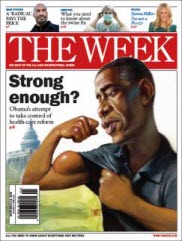 With this approach, The Week is profitable and growing steadily. It’s on track to make $6.3 million this year and its total circulation has grown by 5x since it launched in 2001. (It’s not doing any original reporting though, so you could make a case that it’s just piggybacking on the efforts of others.)
With this approach, The Week is profitable and growing steadily. It’s on track to make $6.3 million this year and its total circulation has grown by 5x since it launched in 2001. (It’s not doing any original reporting though, so you could make a case that it’s just piggybacking on the efforts of others.)
What’s funny is how those numbers aren’t big enough for others in the industry. Mark Edmiston, a former Newsweek president and founder of Nomad Editions, is quoted as saying, “This is not a multimillion-circulation publication, and that’s where you’re going to hit the profits…It doesn’t have a mass market appeal, nor do I ever think it will. It’s very difficult to generate a $30 million, $40 million profit when you’re that small.”
Newsflash: When you’re that small, you don’t NEED to generate $40 million in profit. That’s the nice thing about being small. 300 employees generating $30 million in profit – the multimillion-circulation publication model – is $100,000 per employee. With 32 employees generating $6.3 million, The Week is generating nearly $200,000 per employee. If you’re making twice as much per staffer as your competition, that ain’t too shabby.
Related Signal vs. Noise posts
Ranking tech companies by revenue per employee
More on payroll and efficiency


